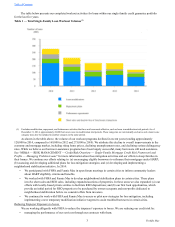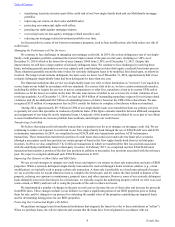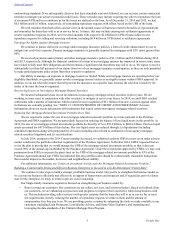Freddie Mac 2014 Annual Report Download - page 18
Download and view the complete annual report
Please find page 18 of the 2014 Freddie Mac annual report below. You can navigate through the pages in the report by either clicking on the pages listed below, or by using the keyword search tool below to find specific information within the annual report.
13 Freddie Mac
The To Be Announced Market
Single-family fixed-rate PCs generally trade on a “generic” basis, also referred to as trading in the TBA market. A TBA
trade is a contract for the purchase or sale of PCs to be delivered at a future date; however, the specific PCs that will be
delivered are not known (i.e., “announced”) until shortly before the trade is settled. The use of the TBA market increases the
liquidity of mortgage investments and improves the distribution of investment capital available for residential mortgage
financing, thereby helping us to accomplish our statutory mission. The Securities Industry and Financial Markets Association
publishes guidelines pertaining to the types of mortgages that are eligible for TBA trades. Certain of our PC securities are not
eligible for TBA trades, such as those backed by relief refinance mortgages with LTV ratios greater than 105%.
Other Guarantee Commitments
In certain circumstances, we provide a guarantee on mortgage-related assets held by third parties, in exchange for a
management and guarantee fee, without securitizing those assets. For example, we provide long-term standby commitments to
certain of our single-family customers, which obligate us to purchase seriously delinquent loans that are covered by those
commitments. From time to time, we have consented to the termination of our long-term standby commitments and
simultaneously entered into guarantor swap transactions with the same counterparty, issuing PCs backed by many of the same
mortgage loans.
Underwriting Requirements, Quality Control Standards, and the Representation and Warranty Framework
We use a process of delegated underwriting for the single-family mortgage loans we purchase or securitize. In this
process, our contracts with sellers describe mortgage eligibility and underwriting standards, and the sellers represent and
warrant to us that the mortgage loans sold to us meet these standards. In our contracts with individual sellers, we may waive or
modify selected underwriting standards. Through our delegated underwriting process, mortgage loans and the borrowers’
ability to repay the loans are evaluated using a number of critical risk characteristics, including, but not limited to: (a) the credit
profile of the borrower (e.g., credit score, credit history, and monthly income relative to debt payments); (b) the documentation
level; (c) the number of borrowers; (d) the features of the mortgage itself; (e) the purpose of the mortgage; (f) occupancy type;
(g) the property type and market value; and (h) LTV ratio. Our single-family loans are generally underwritten with a
requirement for a maximum original LTV ratio of 95%. We prescribe maximum LTV ratio limits of 80% for cash-out refinance
loans and 90% for jumbo conforming mortgages, but no maximum for fixed-rate HARP mortgages. In December 2014, we
announced guidelines for mortgages with LTV ratios up to 97% to serve a targeted segment of creditworthy borrowers. We
expect to begin our purchase and guarantee of mortgages under this initiative in March 2015.
The majority of our single-family mortgage purchase volume is evaluated using our proprietary automated underwriting
software (Loan Prospector), the sellers’ own software, or Fannie Mae’s proprietary software. We use underwriting software and
available data to help us identify loans with potential underwriting defects. The percentage of our single-family mortgage
purchase volume (acquired under purchase volume agreements and excluding HARP and other relief refinance loans) evaluated
by the loan originator using Loan Prospector prior to being purchased by us was 47% and 45% during 2014 and 2013,
respectively. We monitor the performance of loans delivered to us that were underwritten using underwriting software other
than Loan Prospector to determine whether their performance is in line with our risk tolerance.
We review a sample of the loans we purchase to validate compliance with our underwriting standards. In addition, we
review many delinquent loans and loans that have resulted in credit losses, such as through foreclosure or short sale. Beginning
with loans delivered in 2013, in conjunction with our revised representation and warranty framework discussed below, we
began to make changes to reduce the time it takes to complete our quality control review after the loan is delivered to us. We
have implemented tools, such as our proprietary Quality Control Information Manager, to provide greater transparency into our
customer quality control reviews. We have also implemented a process of targeted quality control sampling of loans with
certain characteristics. We expect that further enhancements to these systems and processes will continue in 2015.
If we discover that representations and warranties were breached (i.e., that contractual standards were not followed), we
can exercise certain contractual remedies to mitigate our actual or potential credit losses. These contractual remedies may
include the ability to require the seller/servicer to repurchase the loan at its current UPB, reimburse us for losses realized with
respect to the loan after consideration of any other recoveries, and/or indemnify us.
At the direction of FHFA, we and Fannie Mae revised our representation and warranty framework for conventional loans
purchased by the GSEs on or after January 1, 2013. Under this revised framework, sellers are relieved of certain repurchase
obligations for loans that meet specific payment requirements. This includes, subject to certain exclusions, loans with 36
months (12 months for relief refinance mortgages) of consecutive, on-time payments after we purchase them. At the direction
of FHFA, we announced certain additional changes to our representation and warranty framework during 2014. These changes
include providing repurchase relief on loans that: (a) have established an acceptable payment history (i.e., no more than two 30-
day delinquencies and no 60-day delinquencies in a 36 month period); or (b) satisfactorily completed a review in our quality
control process. We also made changes that provided additional clarity around life-of-loan exclusions from repurchase relief.
These changes are generally designed to provide sellers with a higher degree of certainty and clarity regarding their repurchase
Table of Contents
























